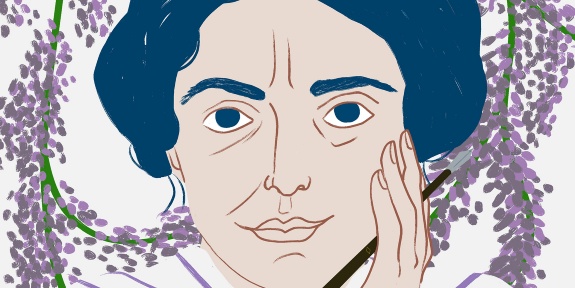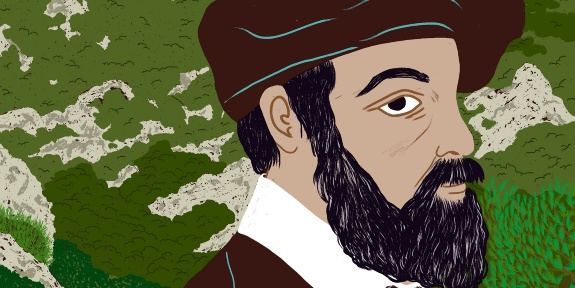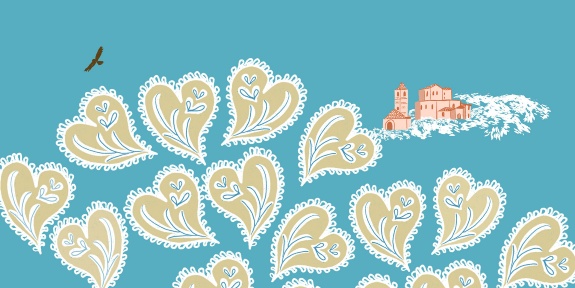Literary itineraries
“Nuoro is jokingly referred to by young Sardinian artists as the Athens of Sardinia. In fact, relatively speaking, it is the most cultured and combative town on the island.” These words were written by Grazia Deledda in 1894, in the introduction to an article about popular traditions in her hometown that was published between August of that year and May 1895 in the periodical Rivista delle tradizioni popolari italiane, edited by Angelo De Gubernatis.
And that was where this epithet, still in use today, acquired its ‘official’ character: Nuoro, the Sardinian city of the arts and literature.
And yet, a little further down in the same text, the writer, who went on to win the Nobel prize in 1927, frames the town in terms of its poverty, starting with the ‘groups of brown houses, covered in moss, with ruined gardens and walled courtyards, like the remains of a destroyed and forgotten medieval village’.
What Deledda is describing is the little town of her childhood and early youth. Poor, yes: but it’s a dignified poverty, like its population’s character. A town that largely looked to its boundless countryside and the mountains around it, populated by peasants and, to an even greater degree, shepherds. But also, a town that still had an old landed gentry, by then on the brink of being displaced by the middle class, now that the specter of the new Kingdom was finally being felt even here. This was noted by the great twentieth-century Italian man of letters, and formidable travel writer, Guido Piovene: while in Nuoro, he was often struck by the sound of “people who talk in a shout: people from the countryside, used to large, uninhabited spaces.” These spaces are the front side of the painting where Grazia Deledda wove the stories that immortalized her name. But on the back, the writer also depicted the city streets where the old world of the farming culture mixed with that of the middle class, by that point grafted onto the fading aristocracy. The world of the great poet and lawyer Sebastiano Satta, more popular – as Piovene also observed – than Deledda, at least among their fellow townspeople.
Some who have written about Nuoro were born there; others just passing through. Arriving in Nuoro in an impossibly uncomfortable and ramshackle coach, D.H. Lawrence stepped into the high street, Corso, and immediately glimpsed traces of the renowned female writer, perhaps even in the semi-eponymous fortuitousness of a barbershop sign emblazoned ‘De Ledda’. About ten years later, a giant of twentieth-century Italian literature, the novelist Elio Vittorini, also arrived by coach – in this case, a busy torpedone. Vitorini’s trip to Sardinia was a tour de force of just a few days, north to south by land and then a quiet, peaceful trip back up by sea. The stay was organized by a magazine that was offering a prize for the best Sardinia travel diary, with the aim of conjuring another literary sojourn, that of Gabriele D’Annunzio, who had also been to Nuoro (with Edoardo Scarfoglio and Cesare Pascarella), leaving with Barbagia in his heart. Vittorini, like Lawrence before him, did not pick up on the nascent middle-class element in Nuoro: although, of course, how could he have, in so little time? But at a certain point, while climbing up the Cathedral hill (a ‘barren summit’), he glimpsed a man partly hidden amidst the prickly pears, being attacked by carrion crows: cousins, we imagine, of Salvatore Satta’s crows: “Nuoro was nothing but a perch for the crows, yet like all Gaul, and even more so, it was divided in three parts.” In these three historical quarters – Séuna, San Pietro and the central area around Corso, the high street – one found the different classes that made up the town’s social framework: the peasants of Séuna, the shepherds of Santu Predu and the aristocracy of Corso, to which one now had to add the nascent middle class, a trace of the modernity that was wiping out the world of once upon a time. This might be why Satta’s city begins, at least symbolically, at the cemetery.
In the last quarter of the nineteenth century, other literary figures besides Grazia Deledda lived and worked in Nuoro, not only the already mentioned Sebastiano Satta, who wrote in both Sardinian and Italian, but also Pascale Dessanay, who is remembered for his work in limba, or Sardinian dialect, and of course the painter Antonio Ballero, who also tried his hand at writing novels, publishing Don Zua. Storia di una famiglia nobile nel centro della Sardegna in 1884. But it was through Deledda and Satta that Nuoro found literary immortality, within the context of a well-defined age. Changed, and yet in some ways always indebted to that of those two extraordinary writers, the city would again play a leading role in the books of other authors, from Maria Giacobbe to Marcello Fois. Let’s take a walk through its streets, then, with Grazia Deledda and Salvatore Satta as our guides.
 Nuorese Cultural District
Nuorese Cultural District



